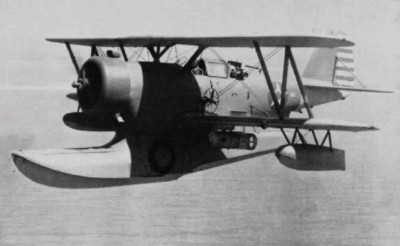![]() The Pacific War Online Encyclopedia
The Pacific War Online Encyclopedia
|
| Previous: J1N "Irving", Japanese Fighter | Table of Contents | Next: J2M "Jack", Japanese Fighter |

U.S. Navy. Via Wikipedia Commons
Grumman J2F-5 Duck
| Crew | 3 |
| Dimensions | 39' by 34'0" by
12'4" 11.89m by 10.36m by 3.76m |
| Wing area | 409 square feet 38.0 square meters |
| Weight | 4300-6711 lbs 1950-3044 kg |
| Speed | 188 mph 303 km/h |
| Cruising speed | 150 mph 241 km/h |
| Landing speed | 64 mph 103 km/h |
| Climb rate | 25 feet per second 7.6 meters per second |
| Service ceiling | 27,000 feet 8200 meters |
| Powerplant | 1 950 hp (708 kW) Wright Cyclone R-1820-50 Cyclone nine-cylinder radial engine driving a three bladed propeller. |
| Armament | 1 0.30 Browning flexible machine gun in rear cockpit |
| External stores | 2 100 lb (45kg) bombs plus two 325 lb (147kg) depth charges |
| Range | 780 miles 1260 km |
| Fuel | 190 gallons 719 liters |
| Production | Total of 320 J2F-1 to -5 from
Grumman Aircraft Engineering Corp, Bethpage, NY 330 J2F-6 from June 1941 at Columbia Aircraft, Valley Stream, NY |
The Duck was produced in sizeable
numbers and variations,
and was popular with its crews.
However, it had been
superseded by the SOC Seagull
as a battleship
and cruiser
floatplane by the time war broke out in the Pacific, though a few were
still in
the Philippines
as coastal patrol
aircraft, and a number saw combat in the Atlantic theater.
The Duck was one of Grumman's first designs,
dating back to 1932. It was intended as a replacement for the Loening
amphibian, and the prototype first flew on 24 April 1933. Production
deliveries began at the end of 1934. About 23 went to Argentina and a
similar number to the U.S. Coast
Guard. The first variant to be called the "Duck" was the 1940
J2F-5. The final J2F-6 model was built by Columbia Aircraft under
license.
References
The Pacific War Online Encyclopedia © 2007, 2009 by Kent G. Budge. Index